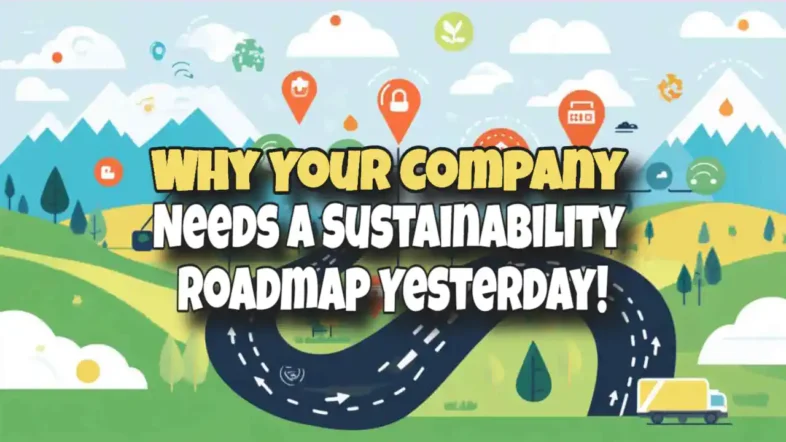Why You Need a Sustainability Roadmap for Your Company Right Now!
In today’s business environment, sustainability is no longer just a buzzword; it’s a critical component of any successful enterprise. As global pressures mount from stakeholders, consumers, and regulators, companies without a clear sustainability roadmap risk falling behind. This article will explore why your company needs a sustainability roadmap immediately, how it benefits long-term growth, and the key steps to develop an effective strategy.
Introduction: The Urgency of Sustainability
Sustainability is transforming from a ‘nice-to-have’ to a ‘must-have’ for companies across all industries. As climate change, resource scarcity, and social inequities continue to challenge the global economy, businesses are being called upon to respond. Those who fail to act quickly risk not only reputational damage but also financial losses and regulatory penalties. This is why having a sustainability roadmap is no longer optional—it’s imperative.
The Business Case for a Sustainability Roadmap
1. Meeting Regulatory Requirements
Governments worldwide are tightening regulations on carbon emissions, waste management, and social responsibility. The European Union’s Green Deal and the United States’ recent climate initiatives are prime examples of how regulations are becoming more stringent. A well-structured sustainability roadmap ensures compliance with these evolving standards, avoiding fines, sanctions, and reputational damage.
2. Enhancing Brand Reputation and Consumer Trust
Today’s consumers are more informed and conscientious than ever before. They prefer to buy from companies that demonstrate a genuine commitment to sustainability. According to a Nielsen survey, 81% of global consumers feel strongly that companies should help improve the environment. A sustainability roadmap not only aligns with consumer values but also enhances brand loyalty and trust.
3. Attracting and Retaining Talent
The workforce is evolving, with millennials and Gen Z accounting for a significant portion of the labor market. These generations prioritize working for companies that are purpose-driven and sustainable. A clear sustainability strategy can help attract top talent and increase employee retention, driving innovation and long-term growth.
4. Unlocking Financial Performance and Reducing Costs
Sustainability initiatives often lead to cost savings through increased efficiency, waste reduction, and energy savings. Additionally, sustainable companies can access new markets, attract investors interested in Environmental, Social, and Governance (ESG) criteria, and potentially benefit from favourable financing terms.
According to a McKinsey report, companies with strong ESG profiles have a lower cost of capital and better operational performance.
5. Future-Proofing Against Market Shifts
As the global economy shifts towards sustainability, businesses that fail to adapt risk becoming obsolete. Industries such as energy, automotive, and manufacturing are already experiencing disruptions due to the transition to a low-carbon economy. A sustainability roadmap prepares companies for these shifts, ensuring long-term viability and competitive advantage.

Developing a Sustainability Roadmap: Key Steps
1. Assessing Your Current Impact
The first step in developing a sustainability roadmap is to conduct a comprehensive assessment of your company’s current environmental and social impact. This involves analyzing your carbon footprint, energy usage, waste generation, and social practices. Tools such as Life Cycle Assessment (LCA) and carbon accounting can provide valuable insights into areas that require improvement.
2. Setting Clear, Measurable Goals
Once you have a clear understanding of your current impact, the next step is to set specific, measurable, achievable, relevant, and time-bound (SMART) sustainability goals. These goals should align with broader industry standards such as the United Nations’ Sustainable Development Goals (SDGs) and be tailored to your company’s unique context.
3. Engaging Stakeholders
Sustainability is a collective effort that requires the involvement of all stakeholders, including employees, customers, suppliers, and investors. Engaging stakeholders early in the process ensures buy-in, facilitates collaboration, and helps identify potential challenges and opportunities.
4. Integrating Sustainability into Core Business Functions
For a sustainability roadmap to be effective, it must be integrated into the core functions of the business, from supply chain management to product development and marketing. This involves embedding sustainability principles into the company’s mission, vision, and values, and ensuring that all departments are aligned with the roadmap’s goals.
5. Implementing and Monitoring Progress
Implementation is where the rubber meets the road. This phase involves rolling out sustainability initiatives, training employees, and making necessary operational changes. Regular monitoring and reporting are crucial to track progress, identify areas for improvement, and adjust strategies as needed. Tools like Key Performance Indicators (KPIs) and sustainability dashboards can be used to measure success.
6. Communicating Your Sustainability Story
Transparency is key to building trust and credibility. Companies should communicate their sustainability efforts and progress through regular reports, social media, and other channels. This not only keeps stakeholders informed but also demonstrates accountability and commitment to continuous improvement.
Key Takeaways
- Sustainability is Urgent: Companies need to act now to meet regulatory requirements, enhance their brand, and attract talent.
- Financial and Operational Benefits: A sustainability roadmap can unlock cost savings, drive financial performance, and future-proof your business.
- Strategic Implementation: Developing a sustainability roadmap involves assessing impact, setting goals, engaging stakeholders, and integrating sustainability into core functions.
- Continuous Improvement: Regular monitoring, reporting, and communication are essential for the ongoing success of your sustainability strategy.
Sustainability Roadmap FAQs
What is a sustainability roadmap?
A sustainability roadmap is a strategic plan that outlines a company’s goals, initiatives, and actions to improve its environmental and social impact. It serves as a guide for integrating sustainability into all aspects of the business, from operations to corporate governance.
Why is a sustainability roadmap important for my business?
A sustainability roadmap is crucial because it helps companies comply with regulations, enhance brand reputation, attract talent, reduce costs, and future-proof against market shifts. It also positions the company as a leader in sustainability, which can drive long-term success.
How do I start creating a sustainability roadmap?
Start by assessing your current environmental and social impact, then set clear and measurable sustainability goals. Engage stakeholders, integrate sustainability into core business functions, and monitor progress regularly. Communication is also key to maintaining transparency and accountability.
What are the financial benefits of a sustainability roadmap?
A sustainability roadmap can lead to cost savings through increased efficiency and waste reduction. It can also attract investors focused on ESG criteria, potentially leading to lower capital costs and better financial performance.
How often should a sustainability roadmap be updated?
A sustainability roadmap should be a living document that is reviewed and updated regularly, at least annually. This ensures that it remains relevant and aligned with evolving industry standards, regulatory requirements, and company goals.
By adopting a sustainability roadmap, companies can not only contribute to a healthier planet but also achieve long-term business success. The time to act is now—before it’s too late.
InstaDoodle Review – A Low Cost Whiteboard Sketch Video Software for Info and Promo Videos
Looking for affordable whiteboard animation software? InstaDoodle – Whiteboard Sketch Video Software helps create engaging explainer and promo videos with ease. Try it now
What is SAF Made Of? An Introduction to Sustainable Aviation Fuel
Discover what is saf made of as we explore sustainable aviation fuel composition, including organic waste, crop residues, and other renewable sources powering eco-friendly flights
Top 5 Skateboard Wall Mounts: A Comprehensive Review Guide
Finding the right place for your skateboard can be hard. One fact: wall mounts keep boards safe and show them off. This article reviews the top 5 skateboard wall mounts, helping you pick the best one. Read on! Top 5 Skateboard Wall Mounts Quick Recommendation For a quick recommendation, take a look at our brief […]
Conquering the Crack: A Guide to Healing Butt Crack Pain and Split Skin
Let’s face it, butt crack woes are a universal experience. Butt crack pain from the irritating itch to the sharp sting of a split, this tender area can cause a surprising amount of discomfort. But fear not, fellow behind-bearers! This comprehensive guide will equip you with the knowledge and strategies to heal a split bum […]






